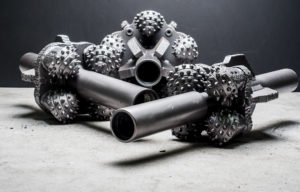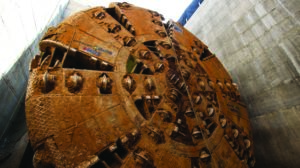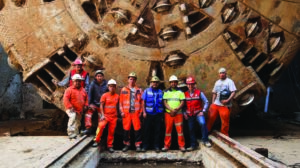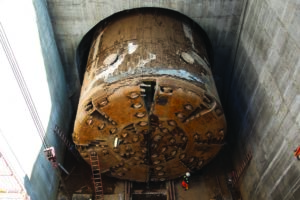Blog, Industry News, trenchless products
XL-I Series Hole Openers Are Designed From the Ground Up For HDD
 (Hutchinson, Kansas) – StraightLine HDD recently expanded its hole opener offering with the introduction of the XL-I Series. Designed from the ground up for horizontal directional drilling, the XL-I Series is positioned as a cost-effective alternative to “split-bit” hole openers.
(Hutchinson, Kansas) – StraightLine HDD recently expanded its hole opener offering with the introduction of the XL-I Series. Designed from the ground up for horizontal directional drilling, the XL-I Series is positioned as a cost-effective alternative to “split-bit” hole openers.
At the core of the design are proprietary cones—available in six sizes, in either Tungsten Carbide or Mill Tooth configurations. Mounted to a purpose-built platform, the design facilitates load transfer to the shaft and bearing, with minimal radial load. The result is a dramatic improvement in production, service life and consistency, bore after bore.
Next, designers set out to address wear and performance characteristics by re-examining the interplay between cone diameter, height and carbide placement. Cones are sized and attached to the baseplate at an angle that protects vulnerable surfaces. Shortened cone height further improves wear resistance. Carbides placed to cut independent paths yield higher efficiency and longer service life.
Internally, the cone’s proprietary sealing and bearing system mitigates fluid intrusion, yielding a myriad of user benefits, from reduced torque and fuel consumption to extended tool life.
As a platform, the XL-I Series incorporates design characteristics that ensure the tool’s original geometry is maintained—even after rebuild. This approach yields consistent and repeatable performance.
The XL-I Series includes six sizes, from 12.75- to 24-inches with IF Box x Box shafts.
About StraightLine HDD
Since 1984, StraightLine has produced drilling solutions” to the trenchless industry. It’s full line of down-hole tools, wear parts and accessories are known for their innovative and rugged design. The portfolio now includes the full array of hard condition tools under the Armadrillco brand. In 2015, StraightLine HDD merged operations with Source: HDD, Inc., a leading provider of used HDD rigs and support equipment. Together, the merger created a company offering total HDD solutions—from rig to bit. Call 620.802.0200 or visit www.straightlinehdd.com for details.
Industry News
 Apply for ISTT’s International No-Dig Awards!
Apply for ISTT’s International No-Dig Awards!
Deadline of submission: 15th August 2017 (Extended from 31st July!)
The winner will be announced at No-Dig Colombia (25-27th September 2017)
Four categories are eligible to receive Awards as shown below. Awards may not be made in all categories in a given year.
- Academic research or training aid/course.
- Trenchless project completed.
- New machine, tool, material, system or technique introduced.
- Student or young professional paper – Members regularly enrolled in college or university, or spending at least half their time on academic course work
The aim of ISTT is to promote the science and practice of trenchless technology, and the Awards are to raise the profile and status of the Society and its Award Winners. All award winners (1) are recognized at the Gala dinner and presented a trophy and certificate, (2) are featured in an article in Trenchless International, (3) are added to the published list of ISTT award winner role of honor posted on the ISTT website, and (4) are authorized to use the ISTT logo on promotional material related to the award activity or recipients. In addition, the winner may be afforded an opportunity to make a brief presentation on the activity that received the award at the Conference time and schedule permitting. The student award winner receives a small cash award and limited financial travel assistance to attend the Conference. Visit the ISTT website for details!
Blog, Industry News, trenchless projects
Custom Robbins Machine finishes on a High Note under Low Cover
 On June 8, 2017, a select group of project officials, including Mexico’s President Enrique Peña Nieto, celebrated the final breakthrough of an epic tunneling project. The 8.7 m (28.5 ft) diameter Robbins Crossover TBM is the first such hybrid machine to operate in North America, and it completed the Túnel Emisor Poniente (TEP) II on a high note. The TBM, known an XRE—a Crossover (X) between Rock (R) and EPB (E) TBMs—navigated fault zones, variable ground, low cover, and more to achieve a national record of 57 m (187 ft) in one day as well as maximum rates of 231 m (758 ft) in one week and 702 m (2,303 ft) in one month.
On June 8, 2017, a select group of project officials, including Mexico’s President Enrique Peña Nieto, celebrated the final breakthrough of an epic tunneling project. The 8.7 m (28.5 ft) diameter Robbins Crossover TBM is the first such hybrid machine to operate in North America, and it completed the Túnel Emisor Poniente (TEP) II on a high note. The TBM, known an XRE—a Crossover (X) between Rock (R) and EPB (E) TBMs—navigated fault zones, variable ground, low cover, and more to achieve a national record of 57 m (187 ft) in one day as well as maximum rates of 231 m (758 ft) in one week and 702 m (2,303 ft) in one month.
“The XRE has a great advantage as it is designed to work in open and/or closed mode (EPB); allowing it to excavate the tunnel either in soil or in rock. We’ve verified that its performance was very efficient,” said Ing. Juan Alberto Herrera Moro y Castillo, TEP II Section Chief for owner CONAGUA, Mexico’s National Water Commission.
The unique machine and its Robbins continuous conveyor system were built on location using Onsite First Time Assembly (OFTA), and designed for a contractor consortium of Aldesem, Proacon, and Recsa. The Robbins XRE TBM featured components like a convertible cutterhead with interchangeable cutting tools, interchangeable TBM belt conveyor and screw conveyor, and multi-speed gearboxes to increase torque for tunneling through difficult ground. “The benefits of the design are in its exceptional thrust power and in the ease of changing the cutterhead torque. This makes the process much easier should the machine become stuck in difficult ground,” said Alberto Martinez, head of the tunneling department for RECSA.
 The XRE machine was launched in August 2015 to bore the 5.8 km (3.6 mi) long wastewater tunnel. The machine was set up in a hard rock configuration and mounted with 20-inch diameter disc cutters. Early in 2016 the TBM hit the first of several contact zones, a 30 m (98.4 ft) wide fault of fractured and blocky rock. While the excavation through the contact zone was slow going, progress picked up again in the more competent andesite rock. After an intermediate breakthrough in March 2016 into an 80 m (262.5 ft) deep shaft followed by inspection and maintenance, the TBM continued on.
The XRE machine was launched in August 2015 to bore the 5.8 km (3.6 mi) long wastewater tunnel. The machine was set up in a hard rock configuration and mounted with 20-inch diameter disc cutters. Early in 2016 the TBM hit the first of several contact zones, a 30 m (98.4 ft) wide fault of fractured and blocky rock. While the excavation through the contact zone was slow going, progress picked up again in the more competent andesite rock. After an intermediate breakthrough in March 2016 into an 80 m (262.5 ft) deep shaft followed by inspection and maintenance, the TBM continued on.
While boring in fractured andesite rock in autumn 2016, the TBM encountered a naturally occurring cavern believed to be the result of either a rock fall in a transition zone, or an old, underground lake body that had eroded the rock away. The cavern was estimated at 90 cubic meters (3,200 cubic ft) in size, including about 57 cubic meters (2,010 cubic ft) of unstable floor area. The TBM was stopped and immediate measures were taken to stabilize the ground in front of the machine with polyurethane foam before filling the cavern with a mixture of pea gravel and grout.
By the end of October 2016, the TBM had reached a final 900 m (2,950 ft) long section of soft ground, where it was converted to EPB mode. In this final reach of tunnel with low cover, the distance from the top of the tunnel to residential home foundations was as low as 4 m (13 ft), and the ground had the consistency of reconsolidated soil. In order to stabilize the soft soils and minimize the risk of settlement below the residential area, the tunneling crew drilled from the surface and installed 890 micro-piles at 1.0 m (3.3 ft) intervals. “We were able to do this without causing damage to property owned by neighbors in the zone bordering the path of TEP II, or to the road or the urban infrastructure installed in that area,” explained Ing. Francisco Miguel Lopez, Jobsite Manager TEP II for contractor Aldesa.
 Now that tunneling is complete, the tunnel will receive a secondary concrete lining of 35 cm (14 in) thickness before going into service. The wastewater tunnel will overhaul the current system in western areas outside of Mexico City and serve to prevent recurrent flooding in Valle Dorado. In particular, the tunnel will benefit the cities of Cuautital Izcalli, Tlalnepantla, and Atizapan de Zaragoza, which altogether are home to 2.1 million inhabitants.
Now that tunneling is complete, the tunnel will receive a secondary concrete lining of 35 cm (14 in) thickness before going into service. The wastewater tunnel will overhaul the current system in western areas outside of Mexico City and serve to prevent recurrent flooding in Valle Dorado. In particular, the tunnel will benefit the cities of Cuautital Izcalli, Tlalnepantla, and Atizapan de Zaragoza, which altogether are home to 2.1 million inhabitants.
Image 1: The 8.7 m (28.5 ft) diameter Robbins XRE TBM was the first Crossover machine to bore in North America.
Image 2: Robbins personnel stand proudly in front of the Crossover TBM for Túnel Emisor Poniente (TEP) II—the project resulted in challenges as well as national records for TBM advance.
Image 3: During its bore, the Crossover achieved a national record for TBM advance, excavating 57 m (187 ft) in one day as well as achieving high rates of 231 m (758 ft) in one week and 702.2 m (2,303 ft) in one month.
Blog, Industry News
 THOMPSON, CONNECTICUT USA, July 5, 2017
THOMPSON, CONNECTICUT USA, July 5, 2017
Numa, the world’s leading drilling technology provider, is proud to announce the addition of Drilling Supplies Europe (DSE) as its new distributor in Ireland. DSE is a leading supplier and manufacturer of consumables and equipment to the ground engineering market and brings a wealth of drilling experience to support the Numa DTH hammer and bit product line.
Established in 2001, DSE was formed to cater to the new and expanding HDD sector in Ireland. The company supplied the day to day consumables such as drilling heads, dies and drilling fluids. In March of 2017, industry veteran Niall Meehan took over as owner and managing director of DSE. Niall has over 20 years of industry experience and has completed numerous projects in the fields of water well, geotechnical, environmental, geothermal, trenchless, CBM and Shale & Gas Storage. DSE brings a great depth of experience to customers along with extensive product knowledge, practical solutions and a friendly service. The company also represents many other leading brands from drilling fluids to drilling rigs, compressors and mud pumps. The combination of a wide range of products, now including Numa DTH hammers and bits, allows DSE to tailor drilling packages to the specific needs of customers in the region.
Ralph Leonard, President of Numa, commented, “We are delighted to have partnered with DSE for the distribution of Numa’s DTH products. DSE is an extremely knowledgeable company focused on service and support which is an essential component to our continued expansion in the European market.”
Niall Meehan owner of DSE added, “Numa is a highly versatile and innovative manufacturer with a big future. We’re proud to be aligned with such a top flight organization as we continue to provide the right solutions for our customers”.
ABOUT NUMA
Numa provides the world’s leading drilling technology with over 110 DTH Hammer and Bit products serving 11 different industries. Our products are designed to drill vertical, horizontal, and reverse circulation holes from 3½ to 48 inches (89 – 1219 mm) in diameter in hard rock, overburden, or loose strata formations. Having customers in 105+ countries, we have built our customer-centric reputation on providing the highest value in products, performance, and personal service available in the rock drilling industry.
ABOUT DRILLING SUPPLIES EUROPE
Established in 2001 and with over 20 years of industry experience, Drilling Supplies Europe is a leading supplier and manufacturer of equipment and materials for both the trenchless and vertical drilling sectors.
The company has the knowledge and experience to provide and support industry with quality, reliable product at affordable prices.
Blog, Industry News, trenchless people
 OLATHE, Kansas, July 10, 2017 — Vermeer Great Plains, a full-service construction equipment dealer with locations in Kansas, Oklahoma, and Western Missouri, is now 100 percent employee-owned through an employee stock ownership plan (ESOP).
OLATHE, Kansas, July 10, 2017 — Vermeer Great Plains, a full-service construction equipment dealer with locations in Kansas, Oklahoma, and Western Missouri, is now 100 percent employee-owned through an employee stock ownership plan (ESOP).
As part of the new ESOP structure, Scott Ryals, former General Manager of Vermeer Great Plains, has taken on responsibilities as Chief Executive Officer. He leads the dealership with a vision focused on maximizing and improving the customer experience, though this goal is nothing new for the dealer’s employees.
“Since Vermeer Great Plains was founded, we have placed a high emphasis on serving our customers, Ryals said.” “The new ESOP plan will only reinforce this culture as the dealership’s success will directly benefit our employees who work every day to take care of our customers. We’re all working toward the same goal.”
Research shows that an employee ownership structure creates a positive work environment as employees all work towards a common goal. In the upcoming months, the employees of Vermeer Great Plains will be further educated about the new ESOP structure.
“The transition to the ESOP means the employees will receive an added future benefit based on how well we all grow the company,” Ryals said.
Customers have always been the most important aspect of the Vermeer Great Plains vision. They can expect even better service as the company learns and grows through this transition. According
to the ESOP Association, 84 percent of companies who participate agree the ESOP improved motivation and productivity. The combination of determined employees, excellent leadership and a
fresh employee-owned plan is sure to be a recipe for success and outstanding customer satisfaction at Vermeer Great Plains.
About Vermeer Great Plains
Vermeer Great Plains is a full-service dealer of Vermeer industrial equipment across Kansas, Oklahoma, and Western Missouri. Established in 1964, the dealership has grown to five locations in the region with 80 team members dedicated to sales, parts and service. Now 100 percent employee-owned, the Vermeer Great Plains team supports customers in the treecare, landscape, wood waste, organic recycling and underground utility construction industries. Vermeer and the Vermeer logo are trademarks of Vermeer Manufacturing Company in the U.S. and/or other countries.
© 2017 Vermeer Corporation. All Rights Reserved.
 (Hutchinson, Kansas) – StraightLine HDD recently expanded its hole opener offering with the introduction of the XL-I Series. Designed from the ground up for horizontal directional drilling, the XL-I Series is positioned as a cost-effective alternative to “split-bit” hole openers.
(Hutchinson, Kansas) – StraightLine HDD recently expanded its hole opener offering with the introduction of the XL-I Series. Designed from the ground up for horizontal directional drilling, the XL-I Series is positioned as a cost-effective alternative to “split-bit” hole openers.






